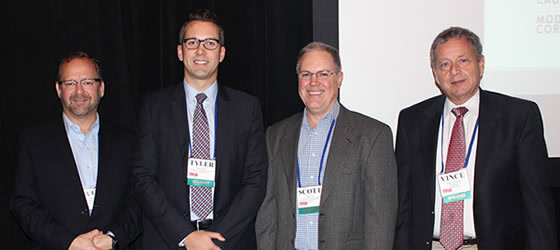Mat Liability – Panel Offers Safety Insights

(l/r) Doug Waldman, Superior Linen Service; Tyler Fowler, Mountville Mills Inc.; Scott Voss, Aramark; and Vince Del Rossi, Health Mats Co.
Working in the field of floor safety poses both challenges and opportunities in today’s world, including litigation involving slip-and-fall accidents. But if you and your staff take a hands-on approach to this business – from the moment a contract is signed through the selection of the right mat for a given location, plus regular maintenance, you can probably avoid liability problems.
That was the rough consensus that emerged from an hour-long panel discussion by three laundry operators and a mat manufacturing executive who spoke during TRSA’s recent Production Summit & Plant Tours in Houston.
Bill Dougherty, vice president of Positek RFID, moderated the Feb. 8 talk by the panel, which included:
- Vincent Del Rossi, president, Health Mats Co., Chester, PA
- Tyler Fowler, president, textile services division, Mountville Mills Inc., LaGrange, GA
- Doug Waldman, president, Superior Linen Service, Tulsa, OK
- Scott Voss, field engineering manager, Aramark Corp., Burbank, CA
Waldman, a former TRSA chair, kicked off the discussion at the Hilton Houston Oak Post, noting that his company has experienced “a few cases,” in which it was sued on allegations of negligence regarding mats, but that they’ve never made a payout. Typically, an accident involving a mat happens when someone trips and falls forward, he said.
One key to limiting liability from mat lawsuits, is to put “disclaimer” language in every contract in prominent fashion so that that customers know the limits of the textile service company’s service obligations. “Your disclaimer should be very clear,” he said. While noting that he’s not a lawyer, Waldman said that the contract language should say that once the mat is placed in the business, the company isn’t responsible if it’s moved to another location. Even if the customers don’t really read the contract, if you make your position clear, it helps if your company is sued, he said.
Waldman added that operators also should be clear and candid about their service offerings. “Never oversell your customers,” he said. “If you don’t do the engineering analysis, don’t say you do.”
False or exaggerated service claims that go unfulfilled can give a plaintiff’s lawyer ammunition to say that if only the laundry operator had done X or Y, the accident wouldn’t have happened.
Del Rossi said his Philadelphia-area company is sued roughly 10 times a year. Usually, accidents occur because a customer relocated the mat and/or didn’t store or place it properly. “Our customers are moving the mats,” he said. “This is where all our lawsuits are coming from.”
To address this problem, Del Rossi’s company developed a brief video to educate customers on the proper placement and storage of mats. Del Rossi aired the video during the session and it offered a brief overview of how mats should be handled.
When lawsuits come up, the claim usually is that the mat was defective, or that the company wasn’t available 24/7 to take care of it. Like Waldman, Del Rossi emphasized the need to make it clear to customers (and to court officials) that their mat service is not provided around the clock and that the company can’t be responsible if customers move the mats or store them improperly.
Voss said that having a good inspection process in place is essential. Service staff should remove any mat as soon as it shows signs of wear. Mats used in grocery stores, hospitals and other buildings where wheeled carts or gurneys are used, will sometimes get ripples in them that may pose a hazard, he said. “Make sure your mats are in good shape,” he said. Heavily trafficked areas call for a thicker mat to avoid the rippling issue he said.
Fowler, the Mountville executive, gave a manufacturer’s perspective noting that a heavier mat, say a 90 “mil” (1 mil equals 1,000th of an inch) can help ensure safety for pedestrian traffic and people pushing carts. Laundry operators need to match the mat to the needs of the customer, he said. “You can’t treat a hospital the same way you’d treat Joe’s machine shop,” he said. In any event, he noted that on balance, “We believe mats prevent far more injuries than they cause.” Mats with special flat borders also can make it easier for carts to move across them.
